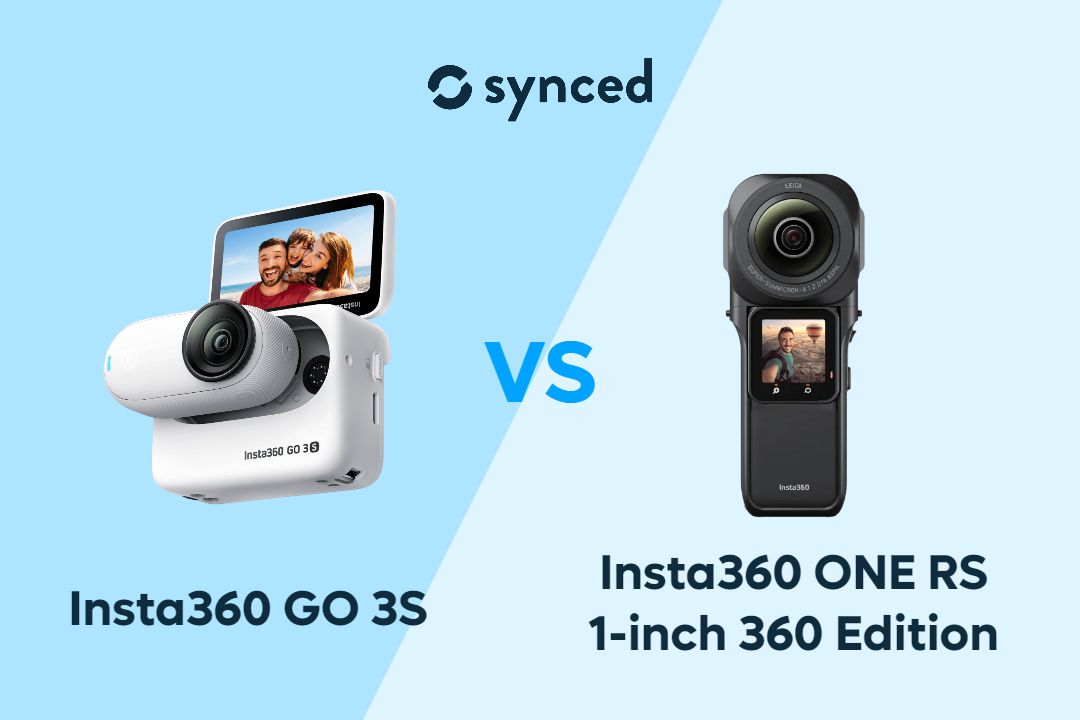Insta360 GO 3S vs DJI Osmo Pocket 3
By Naila Syifa
Updated June 2024

Insta360 GO 3S is a 2024-released ultra-compact and lightweight action camera, designed to capture high-quality video and photos in a variety of situations.
How does it compare to DJI Osmo Pocket 3, a gimbal camera that offers advanced stabilization and imaging capabilities? We'll compare both cameras across 6 aspects to help you decide which one is better suited for your needs.
Key Takeaways
As a gimbal camera, DJI Pocket 3 is mainly used handheld, while Insta360 GO 3S is designed for hands-free and action-oriented use. This is why the GO 3S has far better durability and comes with unique voice & gesture control. However, DJI Pocket 3 wins in terms of low-light imaging and 10-bit lifelike colors. DJI Pocket 3 also offers a timecode function and external microphone support, two professional video production features not available in the GO 3S.


Insta360 GO 3S
Tiny Mighty Action Cam
✓ 4K Video + 12 MP Photo
✓ Compact, Lightweight, Magnetic
✓ FreeFrame & Interval Video Mode
✓ Waterproof to 10m

DJI Osmo Pocket 3
Exceptional Gimbal Camera
✓ 4K Video + 9.4 MP Photo
✓ 1” CMOS Sensor
✓ Timecode Sync
✓ Not Waterproof
#1 Price

Insta360 GO 3S
For a small action camera, the Insta360 GO 3S can be quite an investment at US$399.99. It is the exact same price as last year's 360 camera model Insta360 X3, making it a premium offering in the action camera market.
However, the DJI Osmo Pocket 3 is even more expensive at US$519, which is $220 more than the Insta360 GO 3S. This makes it important to carefully consider the value each camera can provide for your specific needs and budget.
#2 Design & Durability

DJI Osmo Pocket 3
Both cameras have a pocket-friendly design for easy storage and mobility, but the Insta360 GO 3S is significantly smaller and lighter than the DJI Osmo Pocket 3. The camera unit is nearly as small as a thumb, while the Action Pod that houses the camera is just slightly larger.
Insta360 GO 3S features a 2.2" flip touchscreen on its Action Pod, which allows for live previewing and remote control of the camera. Meanwhile, DJI Osmo Pocket 3 features a rotatable 2" touchscreen, which will rotate horizontally or vertically depending on the chosen orientation.
As a gimbal camera, the DJI Osmo Pocket 3 is mainly used handheld. This is perhaps the most obvious difference between the two. Though Insta360 GO 3S can also be used handheld with a selfie stick, the camera's tiny, unobstructed design gives it flexibility for mounting.

Magnet Pendant of the Insta360 GO 3S
The GO 3S is also magnetic and comes with 3 mounting accessories included (magnet pendant, easy clip, and pivot stand), making it more versatile for hands-free use in a variety of situations. The magnet pendant is especially useful for capturing POV shots, while the easy clip can be attached to a pet's collar to capture their point of view.
In terms of durability, the Insta360 GO 3S is again winning. The camera can withstand extreme temperatures ranging from -20°C to 40°C and is waterproof to 33 ft (10m) out of the box. Meanwhile, DJI Osmo Pocket 3 is not waterproof and can't operate in cold temperatures beyond 0°C.
#3 Video & Photo

DJI Osmo Pocket 3
Both cameras have the same maximum video resolution of 4K, but DJI Osmo Pocket 3 supports a higher refresh rate of 60fps compared to the Insta360 GO 3S which maxes out at 30fps for 4K videos.
However, when it comes to photo resolution, the Insta360 GO 3S has it better at 12 MP compared to the 9.4MP photo resolution of the DJI Osmo Pocket 3.
Insta360 GO 3S also offers some interesting video modes that the Pocket 3 doesn't come with. For example, in FreeFrame Video mode, the camera records in a flexible aspect ratio that can be chosen later in post-production. Interval Video mode is also unique in its ability to automatically record footage at set intervals, making it great for capturing all-day activities like family trips or outdoor adventures. Other modes include Pre-Recording and Loop Recording, which can be useful in various situations to ensure you don't miss important moments.

Insta360 GO 3S
Despite lacking those mentioned specialized video modes, the DJI Osmo Pocket 3 stands out with a large 1" CMOS sensor, which makes it excel in low-light performance compared to the smaller sensor in the Insta360 GO 3S.
In addition, DJI Osmo Pocket 3 supports 10-bit D-Log M and HLG color modes, providing more flexibility for color grading and professional video post-production.
#4 Audio

DJI Osmo Pocket 3
DJI Osmo Pocket 3 features a three-microphone array, which allows for improved audio quality and clear voice recording in noisy environments. Besides the usual stereo and directional audio recording, it also has a unique Audio Zoom feature, which automatically adjusts the volume gain based on zoom ratio for dynamic sound capture.
In addition, DJI Osmo Pocket 3 offers support for external microphones, allowing for even better audio recording quality with dedicated audio equipment.
On the other hand, Insta360 GO 3S relies only on its 2 built-in microphones for audio recording and does not offer support for external microphones. This can be a limitation for professionals who require high-quality audio for their videos.
#5 Features

Insta360 GO 3S
In terms of additional features beyond the core video and photo capabilities, both cameras have their own unique advantages.
Insta360 GO 3S supports voice control and gesture control, which makes it easy for hands-free shooting or when the camera is mounted a bit far away. DJI Osmo Pocket 3 offers neither voice control nor gesture control, but you may not need it anyway as it is typically used handheld, unlike the Insta360 GO 3S which is designed for more versatile mounting options.
Insta360 GO 3S is also trackable using Apple Find My, which can be useful if the camera gets misplaced or lost. This is also a unique feature that the DJI Osmo Pocket 3 does not offer, perhaps because the tiny size of the Insta360 GO 3S makes it more prone to getting lost.

DJI Osmo Pocket 3
DJI Osmo Pocket 3, on the other hand, provides support for live streaming that the GO 3S doesn't offer. With the live streaming feature, users can broadcast their videos up to 1080p in real-time to platforms like YouTube, Facebook, and more.
DJI Osmo Pocket 3 also has a built-in timecode function. This feature is useful for professional video production that requires precise synchronization of multiple cameras or audio sources. Meanwhile, Insta360 GO 3S doesn't offer a timecode feature.
Both cameras come with a companion app for easy editing, but they also have distinctive capabilities in this regard. DJI Mimo app, the companion app for the Pocket 3, stands out with its beautification features known as Glamour Effects. Meanwhile, the Insta360 app, the companion app for the GO 3S, boasts a free Auto Editing feature that can automatically select the best shots and create a ready-to-share video with music.
#6 Battery Life

Insta360 GO 3S
When it comes to battery life, the DJI Osmo Pocket 3 has a clear advantage. The camera's 1300 mAh battery can last for up to 116 minutes at 4K/60 fps of continuous recording, or up to 166 minutes in 1080p/24 fps mode.
When used with the Action Pod, the Insta360 GO 3S can last for up to 140 minutes at 1080p/30 fps, which is only slightly longer than the DJI Osmo Pocket 3's battery life. However, without the Action Pod, the camera unit can last for only 38 minutes, a significantly shorter battery life compared to the Osmo Pocket 3.
Insta360 GO 3S vs DJI Osmo Pocket 3
Final Thoughts

DJI Osmo Pocket 3
In conclusion, Insta360 GO 3S is a more suitable choice for casual users who want to capture their adventures and activities in an effortless and versatile manner, thanks to its small size, magnetic mounting options, unique video modes, voice control, gesture control, and AI-powered auto editing tools.
Meanwhile, DJI Osmo Pocket 3 is more suitable for professional video production needs, as well as content creators who mainly record footage in urban situations. Its advanced low-light imaging capabilities, 10-bit color, external microphone support, live streaming, and timecode function make it a better fit for more demanding video production workflows.
If you’d like to read more about Action Camera, check out our other relevant guides here:
Insta360 GO 3S vs GO 3
Insta360 GO 3S vs GO 2
Insta360 GO 3S vs X4
Insta360 GO 3S vs Ace Pro
Insta360 GO 3S vs GoPro Hero 11 Mini
Don't miss out on tech
Subscribe to our newsletter to stay up to date on the latest tech trends and guides on the best gadgets around.











Leave a comment
This site is protected by hCaptcha and the hCaptcha Privacy Policy and Terms of Service apply.